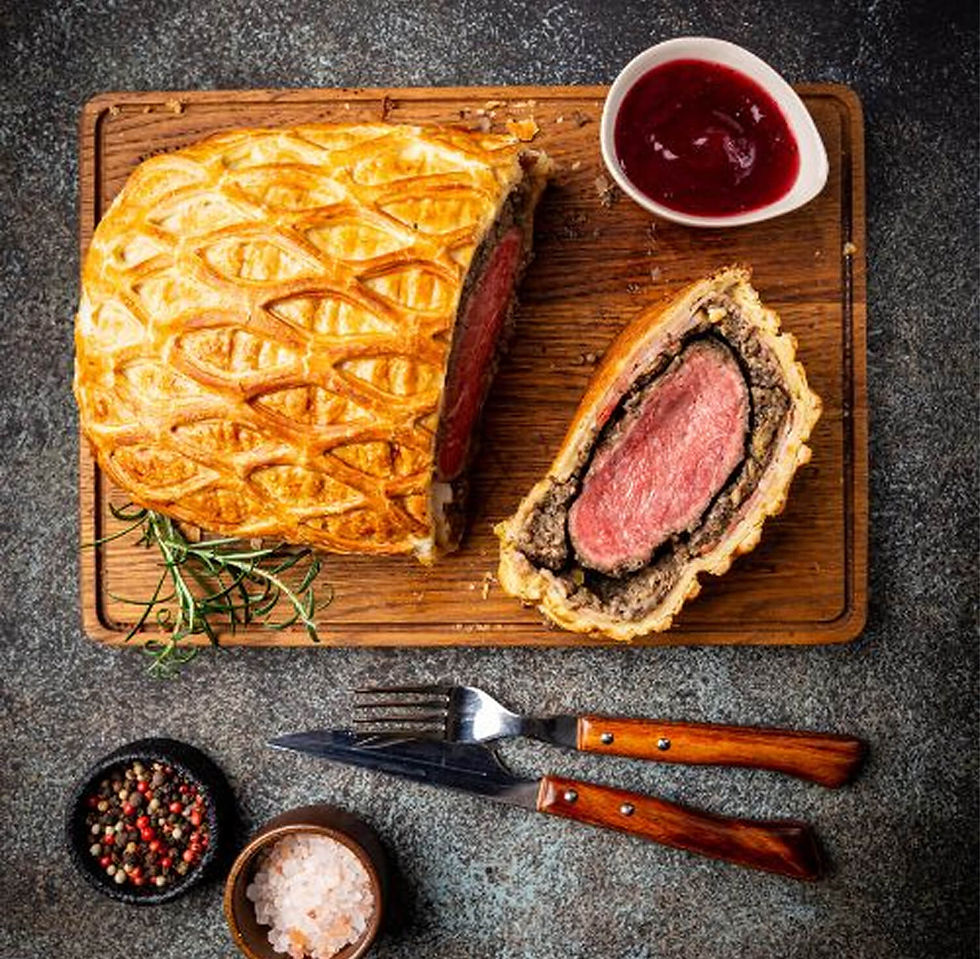Shrimp Scampi
- ckcallighan20209
- Apr 29, 2024
- 3 min read

The word “scampi” in Italian means a small crustacean that is similar to a small lobster. “Scampi” are the same as Dublin Bay Prawns, langoustines, and Norway Lobsters. None of these crustaceans are found in oceans close to the US or sold in our supermarkets, although occasionally you can find langoustines sold frozen in our grocery stores.
American chefs began substituting shrimp for “scampi” and sautéing them in a butter, white wine, and garlic sauce; and the name “shrimp scampi” became attached to this delicious dish. Here in the US, the term “scampi” has evolved to mean anything that is cooked in a butter, white wine, and garlic sauce rather than the crustacean “scampi.”
You can get creative when making scampi and substitute chicken, scallops, salmon, lobster, mussels, or even crab for the shrimp. It is the cooking technique that is distinctive, not the crustacean.
I love making Shrimp Scampi. It is comforting on a cold winter evening or elegant enough for a dinner party.
Shrimp Scampi Serves 4
Serve with crusty bread for dipping in the delicious sauce and a green salad.
For the pasta:
1 package (16-ounces) spaghetti, cooked al dente
Cook spaghetti al dente according to package directions.
¼ cup butter
2 tablespoons extra virgin olive oil
½ cup green onions, thinly sliced
1 tablespoon minced garlic
¼ teaspoon crushed red pepper flakes, or to taste (optional)
1 pound shrimp, peeled and deveined
Salt
Large grind black pepper
½ cup dry white wine
3 tablespoons fresh lemon juice
¼ cup butter
2 tablespoons extra virgin olive oil
½ cup fresh parsley, snipped
Salt
Large grind black pepper
½ cup grated Parmesan cheese
While spaghetti is cooking, in a large skillet, place butter and olive oil over a medium heat. Add green onions, garlic, and crushed red pepper flakes and sauté for 2 minutes.
Season shrimp to taste with salt and pepper. Add shrimp to the skillet and cook until pink, stirring occasionally, about 2 to 3 minutes. Remove shrimp from the skillet, place on a plate, and cover with aluminum foil to keep warm.
Place wine and lemon juice in the same skillet and bring to a boil, scraping any browned bits of food remaining in the skillet with a wooden spoon.
Add an additional ¼ cup butter and 2 tablespoons olive oil to the skillet and reduce the heat to a simmer.
Place spaghetti, shrimp, scampi sauce, and parsley in a large bowl and toss to evenly coat pasta with the scampi sauce. Season to taste with salt and pepper. Sprinkle with Parmesan cheese and toss again or serve Parmesan cheese separately on the side.
Tips on shopping for shrimp: Fresh versus Frozen. Fishermen put shrimp on ice as soon as they are caught. This preserves the shrimp, freezing them so they are just-caught fresh until they are thawed. The fresh shrimp you see on ice in the seafood counter at your supermarket were most likely once frozen and are thawing in the counter. The longer they are in the counter, the less fresh they will be. Unless you know that the fresh shrimp you are buying is fresh off the boat, frozen shrimp is a better choice.
Wild-Caught or Farm-Raised: Wild-caught shrimp have a sharper, more shrimpy taste; however, they are pricier and harder to find. Ninety percent of shrimp sold in the United States are imported from Southeast Asia, Ecuador, and India; and the majority of that is farm-raised. Your supermarket is required to divulge the country of origin and whether shrimp is wild or farmed. Check the label.
If you have doubts, farm-raised shrimp cultivated under cleaner standards will bear a “Best Aquaculture Practices” label. The certification label to look for when buying wild shrimp is “Marine Stewardship Council Approved” .
Do not purchase frozen shrimp that have dry spots on their shells. This is a sign of freezer burn. Except for the black tiger variety of shrimp, black spots on shells are an indication of spoilage. Signs of yellow or grit on the shells could mean the shrimp have been bleached to remove black spots. Avoid shrimp that smell like ammonia or feel soft or slimy.
Carol Ann

Carol Ann Kates is the award-winning author of cookbook, Secret Recipes from the Corner Market and Grocery Shopping Secrets. She’s an expert in how to shop, select, and store produce for maximizing home cooking outcomes and minimizing time and money spent. As a former supermarket and deli operator, Carol Ann shares grocery-insider wisdom—the same expertise you used to receive when patronizing a mom-and-pop establishment. Contact her at CarolAnn@CarolAnnKates.com and explore her website, www.CarolAnnKates.com.
Copyright 2024 All Rights Reserved Carol Ann Kates
1
Searing the Beef
Sear beef fillets on high heat for 2 minutes per side to form a golden crust. Let it cool before proceeding to keep the beef tender.
1
Searing the Beef
Sear beef fillets on high heat for 2 minutes per side to form a golden crust. Let it cool before proceeding to keep the beef tender.
1
Searing the Beef
Sear beef fillets on high heat for 2 minutes per side to form a golden crust. Let it cool before proceeding to keep the beef tender.
1
Searing the Beef
Sear beef fillets on high heat for 2 minutes per side to form a golden crust. Let it cool before proceeding to keep the beef tender.
Notes



1
Season the good fresh beef fillets with salt and black pepper. Heat olive oil in a pan over high heat and sear the fillets for 2 minutes per side until it fully browned. Remove the beef from the pan and brush with a thin layer of mustard. Let it cool.



1
Season the good fresh beef fillets with salt and black pepper. Heat olive oil in a pan over high heat and sear the fillets for 2 minutes per side until it fully browned. Remove the beef from the pan and brush with a thin layer of mustard. Let it cool.



1
Season the good fresh beef fillets with salt and black pepper. Heat olive oil in a pan over high heat and sear the fillets for 2 minutes per side until it fully browned. Remove the beef from the pan and brush with a thin layer of mustard. Let it cool.



1
Season the good fresh beef fillets with salt and black pepper. Heat olive oil in a pan over high heat and sear the fillets for 2 minutes per side until it fully browned. Remove the beef from the pan and brush with a thin layer of mustard. Let it cool.
Instructions
Quality Fresh 2 beef fillets ( approximately 14 ounces each )
Quality Fresh 2 beef fillets ( approximately 14 ounces each )
Quality Fresh 2 beef fillets ( approximately 14 ounces each )
Beef Wellington

Beef Wellington
Fusion Wizard - Rooftop Eatery in Tokyo
Author Name

Beef Wellington is a luxurious dish featuring tender beef fillet coated with a flavorful mushroom duxelles and wrapped in a golden, flaky puff pastry. Perfect for special occasions, this recipe combines rich flavors and impressive presentation, making it the ultimate centerpiece for any celebration.
Servings :
4 Servings
Calories:
813 calories / Serve
Prep Time
30 mins
Prep Time
30 mins
Prep Time
30 mins
Prep Time
30 mins










Comments